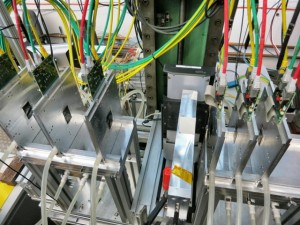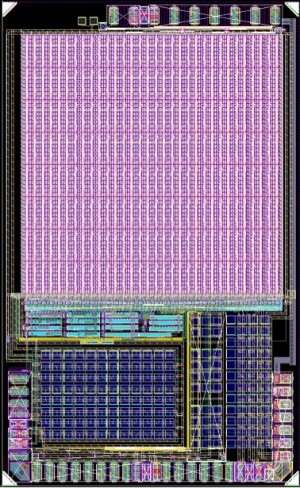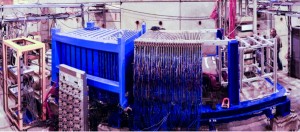The Compact Linear Collider and International Linear Collider will accelerate particles and create collisions in different ways. Nonetheless, the detector concepts under development share many commonalities.
CERN physicist Dominik Dannheim explains that CLIC detector plans are adaptations of the ILC detector designs with a few select modifications. “When we started several years ago, we did not want to reinvent the wheel,” says Dannheim. “The approved ILC detector concepts served as an excellent starting point for our designs.”
Essential differences
Both CLIC and ILC scientists foresee general-purpose detectors that make measurements with exquisite precision. These colliders, however, have very different operating parameters, which will have important consequences for the various detector components. The ILC’s collision energy is set at 500 GeV (with option to upgrade to 1 TeV), while CLIC will collide at up to 3 TeV. And the bunch structure is very different, too. The main difference is in the timing of the collisions. At the ILC electrons and positrons collide in bunch crossings spread out over bunch trains of almost a millisecond. At CLIC these bunch trains last for only 156 nanoseconds. So CLIC detectors will have a tougher job disentangling the rare physics events from the collision background.
The higher energy will give CLIC a greater physics reach, but will also create more unwanted background events with less time to disentangle background from more interesting phenomena. “Simulations have shown that a time resolution at the nanosecond level is needed for most sub-detectors at CLIC,” says Dannheim. “In this respect they will be similar to the ones currently in operation at the LHC, yet aiming for much higher granularity and measurement precision.”
Vertex detector
The detector component closest to the interaction point, where collisions occur, is the vertex detector. ILC concepts place a paper-thin pixel detector near the interaction point to improve the resolution of short-lived particles created in collisions.
The harsher background conditions at CLIC required a redesign of the inner detectors, which included moving the vertex detector further away from the interaction point. CLIC scientists are developing a different type of pixel detector for this region, where thin sensors are coupled to dedicated ultra-fast low-power readout chips (called CLICpix). This technology will help limit the number of overlapping background particles that inevitably blur the result. First prototypes of the newly developed CLICpix readout chip and of 50-μm-thin sensors have recently been produced, marking important milestones for the CLIC vertex detector project. The ultra-thin sensors will be under scrutiny in the DESY test beam telescope in the next two weeks.
Two trackers
There are two detector concepts under consideration for the ILC, the International Linear Detector (ILD) and the Silicon Detector (SiD). CLIC scientists are also evaluating and modifying both ILD and SiD concepts.
In the ILD concept, a large chamber of argon gas –called a time projection chamber– will serve as the main tracker. When charged particles pass through, the surrounding gas ionises. The ionisation charge then drifts in an electric field to the chamber’s edge where it is amplified and recorded. This form of tracking offers more detail in seeing the full path of particles and could be advantageous in identifying long-lived particles that decay leaving a V-shape pattern. However, a time projection chamber takes a long time to receive a signal and the chamber itself requires more than 40 cubic metres of space.
The SiD tracker has a different setup. In this concept, a silicon tracker with five layers of silicon sensors offers a good resolution while interacting minimally with particles. This technology also offers a much faster response time, even if it creates a less detailed picture of certain particle decays. Options are open for a future CLIC detector.
Imaging calorimeters
Perhaps the most exciting element of both CLIC and ILC detector designs is the use of high-resolution calorimeters. The calorimeters will boast an unprecedented number of channels, allowing physicists to identify particle showers with greater accuracy than ever before.
“These are imaging calorimeters,” says Argonne scientist Marcel Demarteau. “They can take pictures layer by layer.” This kind of calorimetry is the current design of choice for many future detectors at electron-positron colliders, enabled by advances in technology that allow embedded integrated electronics and computing to handle the massive flow of data from millions of channels.
While sharing most parts of the calorimeter concepts with the ILC detectors, CLIC requires important changes to the hadronic calorimeters. Specifically, because of the high energy particles created at CLIC, a very dense material will be needed to efficiently absorb these particles. CLIC scientists are currently investigating tungsten, more than twice as dense as the commonly used steel, as an absorber material.
Overall, the ILC and CLIC detector concepts share many of the same technological challenges. Dannheim points out that scientists involved with CLIC and ILC are collaborating in many areas, such as simulation and reconstruction software, calorimeter development and mechanical integration. “There are many opportunities for synergy,” Dannheim says. “Though some of the technical challenges of the two projects are different, we all share the excitement of pushing the limits of detector technology, developing devices that can make a contribution to the future of particle physics.”




Recent Comments